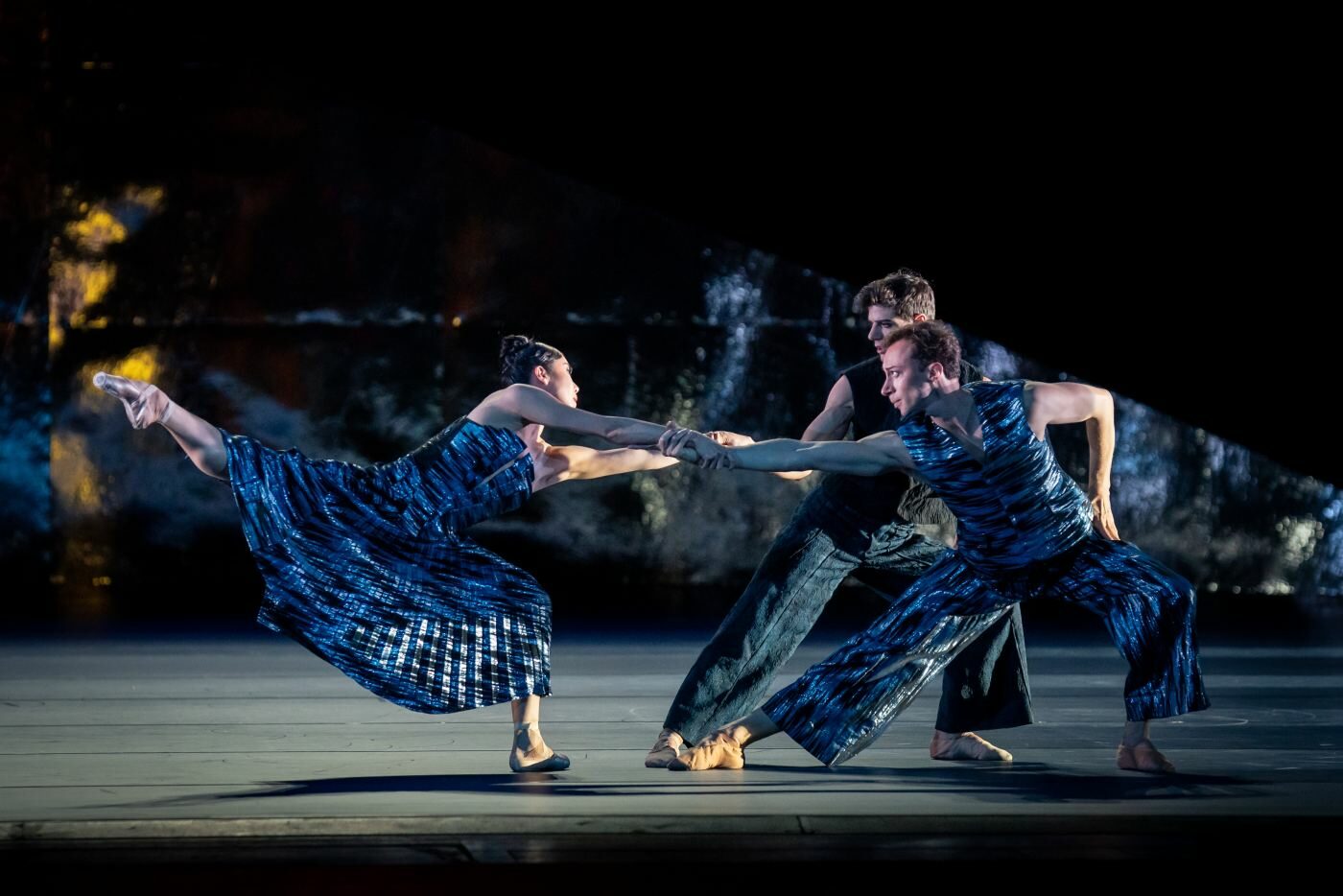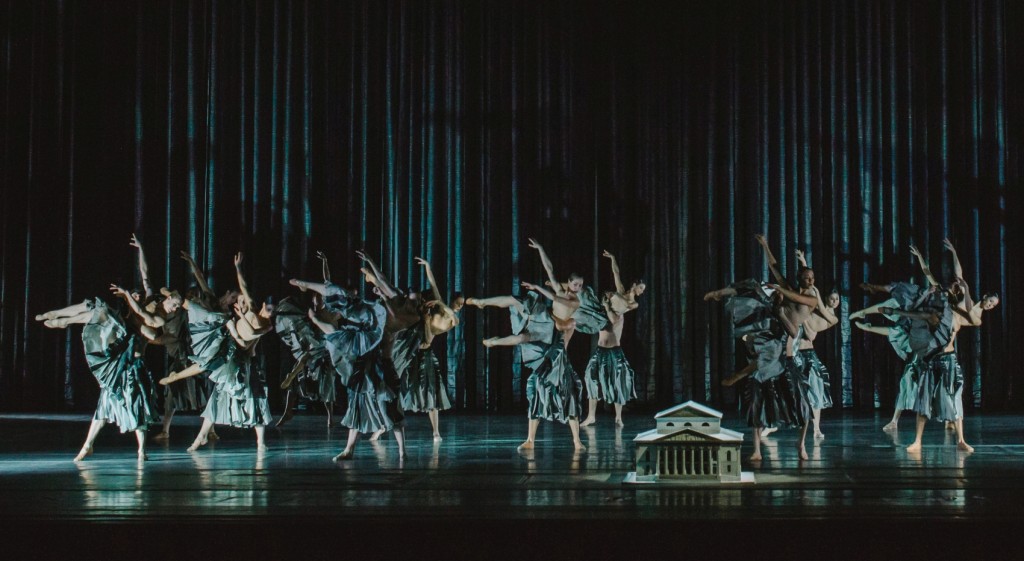“Artifact II / The Exiles / Zugvögel”
Bavarian State Ballet
National Theater
Munich, Germany
June 19, 2015
by Ilona Landgraf
Copyright © 2015 by Ilona Landgraf
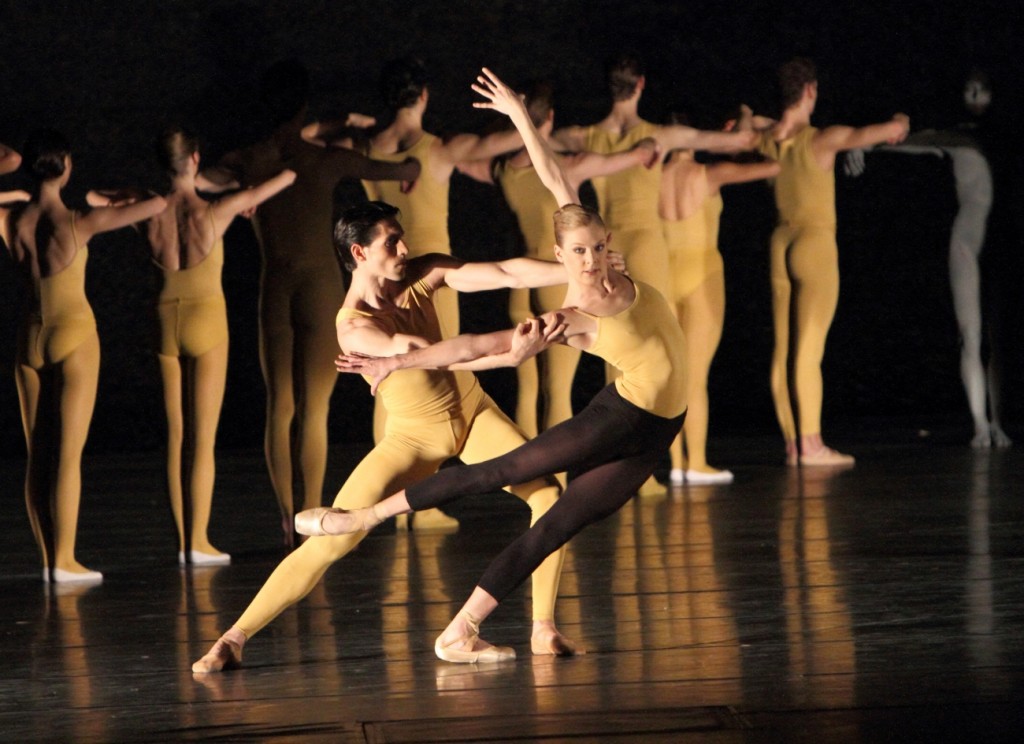 Munich’s National Theater was packed to the roof for the last performance of “Artifact II / The Exiles / Zugvögel”. The triple bill combines two older pieces – “Artifact II” by William Forsythe and “Zugvögel” by Jiří Kylián – with “The Exiles”, a newly acquired work by José Limón. It is the fourth work by Limón in the company’s repertory. Forsythe’s “Artifact II” is the second part of the full-evening, quadripartite “Artifact” which has been in the company’s repertory since 2009. “Zugvögel” (“Migrating Birds”) is a creation by Kylían which opened Munich’s ballet festival week in 2009. Performance rights of “Zugvögel” are reserved for the Bavarian State Ballet.
Munich’s National Theater was packed to the roof for the last performance of “Artifact II / The Exiles / Zugvögel”. The triple bill combines two older pieces – “Artifact II” by William Forsythe and “Zugvögel” by Jiří Kylián – with “The Exiles”, a newly acquired work by José Limón. It is the fourth work by Limón in the company’s repertory. Forsythe’s “Artifact II” is the second part of the full-evening, quadripartite “Artifact” which has been in the company’s repertory since 2009. “Zugvögel” (“Migrating Birds”) is a creation by Kylían which opened Munich’s ballet festival week in 2009. Performance rights of “Zugvögel” are reserved for the Bavarian State Ballet.
The abstract “Artifact II” set to Johann Sebastian Bach’s “Chaconne” of the Partita for Violin No.2 builds suspense by contrasting modern elements of ballet with classical ones. As in historical productions, the corps de ballet frames the pas de deux and solos. Yet the function of Forsythe’s corps is less decorative, but rather forms clear geometrical lines and patterns. The dancers stand in line on either side of the stage and in the back, or alternatively on one side. They form a sharp angle or 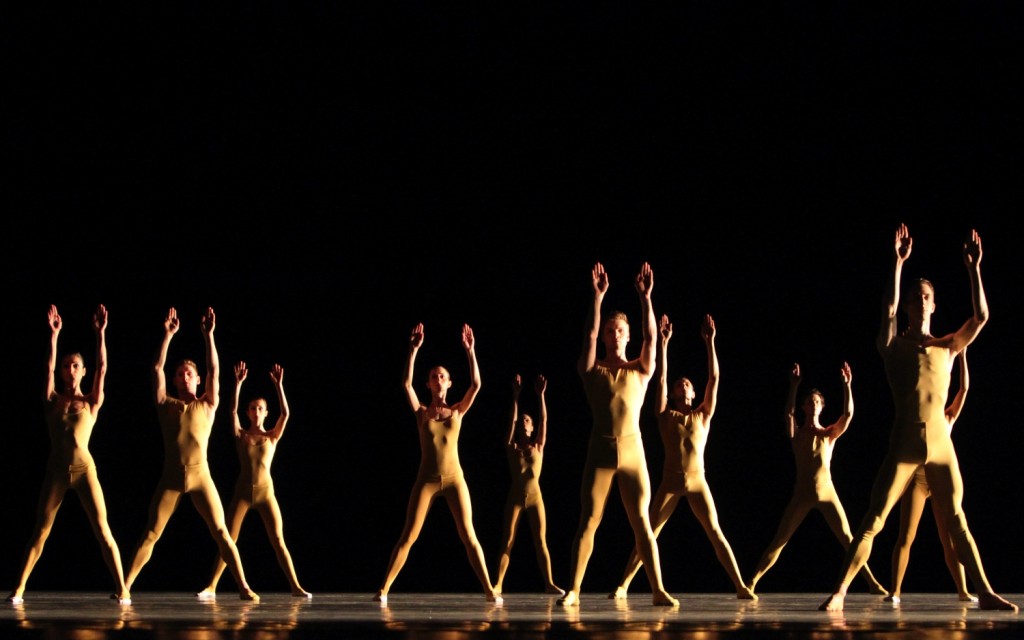 lie along the back stage on their backs. Changes in formation are separated by the curtain going down with a bump. Successions of angular arm movements reminiscent of the ones used when piloting a ship through the harbor enhance the impression of precision.
lie along the back stage on their backs. Changes in formation are separated by the curtain going down with a bump. Successions of angular arm movements reminiscent of the ones used when piloting a ship through the harbor enhance the impression of precision.
In the free space bordered by the corps unfold two pas de deux in typical Forsythe style. The movements are sharp and dynamic, tension is built by a contrast between movement impulses in opposite directions. Both couples dance with vigor. Mia Rudic, partnered by Léonard Engel, shows off her flexibility and snappy attack while Ekaterina Petina and Javier Amo, seemingly having the right chemistry with each other, sizzle. Emma Barrowman as the Mud Woman demonstrates arm gestures in front of the corps like a teacher before slowly walking off stage. She is the only one wearing a light blue tricot. All others are clad in skinny, golden yellow tricots for the women, unitards for the men respectively. Effective and warm lighting gives the bodies a sculptural appearance.
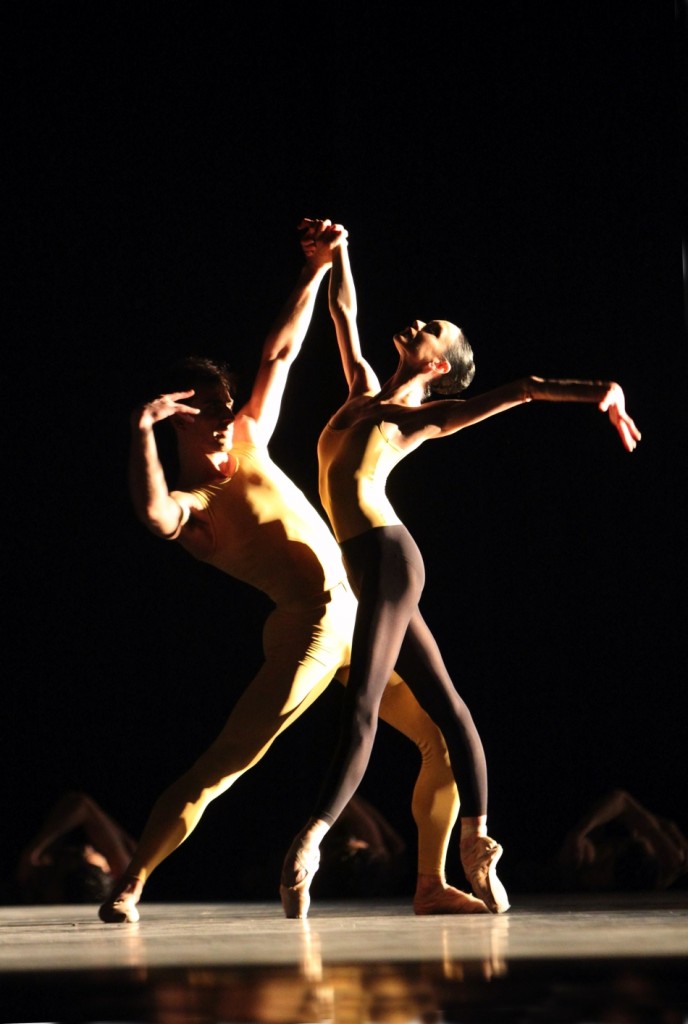 Limón’s “The Exiles”, a creation from 1950, is a pas de deux for a man and a woman about a lost paradise, or the loss of peace, innocence, the homeland. As music Limón chose Arnold Schoenberg’s “Chamber Symphony No. 2, op. 38”. It consists of two movements, an adagio and a movement radiating elated joy followed by a gloomy coda. In the first movement Limón depicted the protagonists’ flight, in the second their remembrance of halcyon days and how these were forfeited. In the coda the dancers face the harsh reality of being expelled again.
Limón’s “The Exiles”, a creation from 1950, is a pas de deux for a man and a woman about a lost paradise, or the loss of peace, innocence, the homeland. As music Limón chose Arnold Schoenberg’s “Chamber Symphony No. 2, op. 38”. It consists of two movements, an adagio and a movement radiating elated joy followed by a gloomy coda. In the first movement Limón depicted the protagonists’ flight, in the second their remembrance of halcyon days and how these were forfeited. In the coda the dancers face the harsh reality of being expelled again.
Matej Urban and Stephanie Hancox portray the Adam and Eve-like couple. Clad in skin-colored, tight costumes and bare-footed they seem to be vulnerable, naked creatures when crossing the stage diagonally as if running away in slow motion. Both look stressed, their movements inhibited. A green rope each of them later wraps around the hip, the upper leg and the torso might symbolize the chains both had been put into by whatever caused their expulsion. Each movement, each gesture is meaningful and carefully executed. Steps aren’t poured out spontaneously but celebrated in a manner similar to a ritual. “The Exiles” is a lesson about existential experiences in life. Due to the piece’s deliberately artificial character the onlooker doesn’t get lost merely watching. Instead eyes and mind stay alert.
Urban and Hancox aptly convey different moods of depression, the feeling of threat, suffering and endurance, contrasting with jumps and friskiness that had happily prevailed before their expulsion. Urban, for example, leaps and bounds around like a young ram; once he reminded one of a faun; on another occasion he resembles a supple, elegant panther. Hancox, at 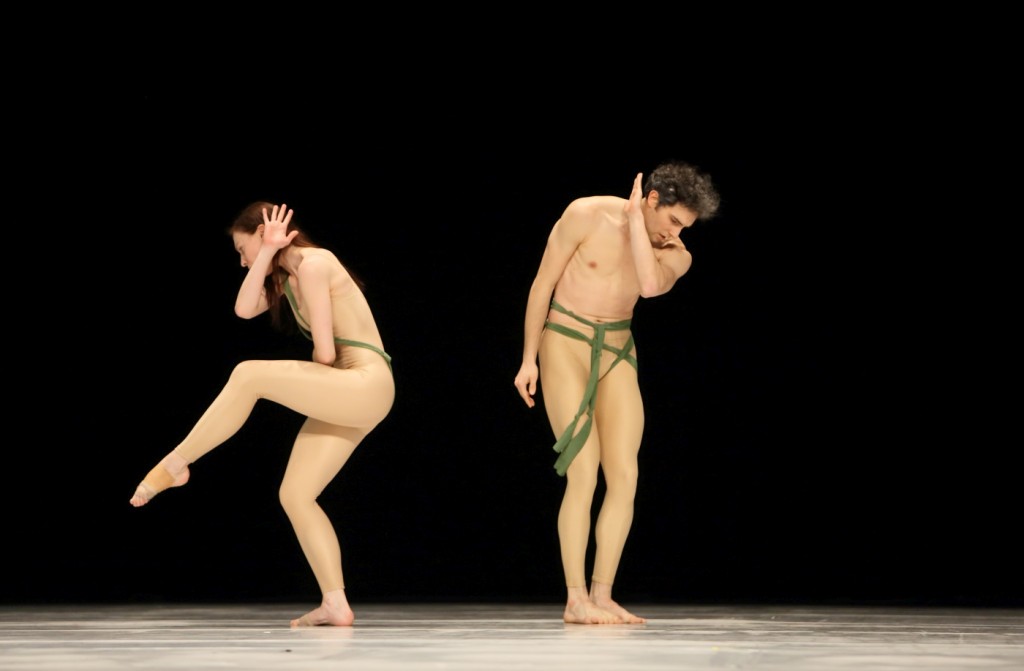 first merely a sexless companion, eventually discovers her libido that inflames her man and vice versa. They circle around each other like reptiles in a jerky court dance before Hancox lets herself fall on Urban, who lies on his back on the floor. Through experiencing sex they gain knowledge. Suddenly nothing is as it was before, the world is perceived in another light.
first merely a sexless companion, eventually discovers her libido that inflames her man and vice versa. They circle around each other like reptiles in a jerky court dance before Hancox lets herself fall on Urban, who lies on his back on the floor. Through experiencing sex they gain knowledge. Suddenly nothing is as it was before, the world is perceived in another light.
In the coda Urban and Hancox walk as they did at the beginning on a diagonal. Hancox runs back and forth seeming to 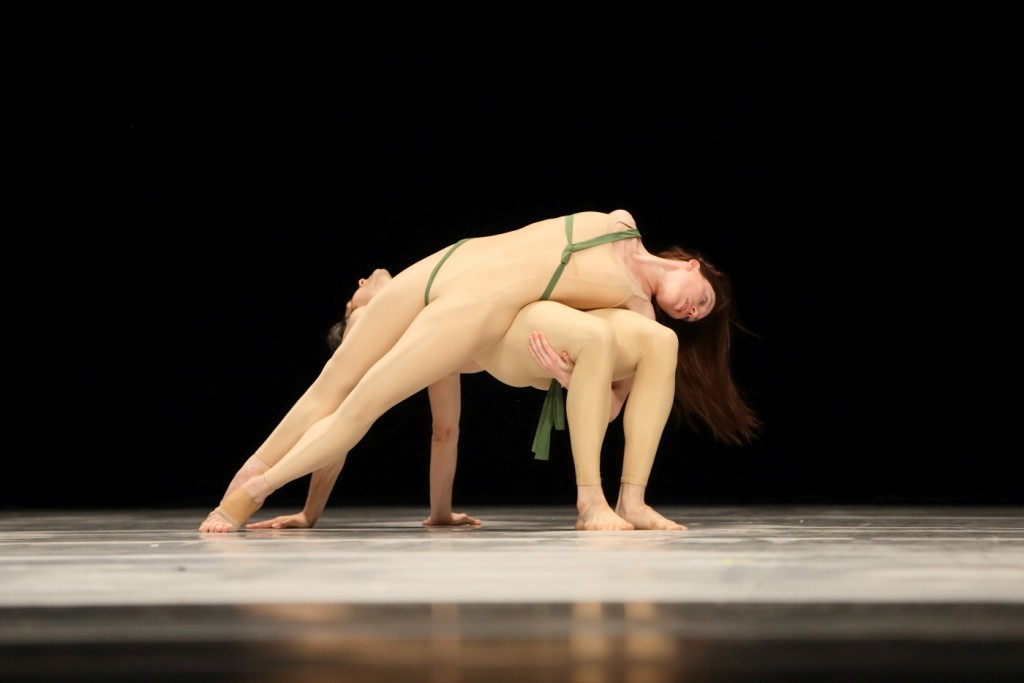 back off from an uncertain or menacing future but hesitating to seek refuge in the past. The moment Urban holds Hancox back both establish a true, intimate relationship for the first time. Though worrying about what awaits them, they continue their wandering together.
back off from an uncertain or menacing future but hesitating to seek refuge in the past. The moment Urban holds Hancox back both establish a true, intimate relationship for the first time. Though worrying about what awaits them, they continue their wandering together.
Kylián’s “Zugvögel” is one of the projects that started in 2000 in Den Haag under the name of “Arcimboldo”. These events open the whole theater complex to the audience: the stage, the understage and also the backstage area. After Den Haag, Kylián conducted Arcimboldos at Copenhagen’s and Oslo’s operas. In his creation for Munich Kylián made the whole building itself, the National Theater, center stage. The title “Zugvögel” results from Kylián’s idea that people – artists, audience members, technicians, staff and so on – would fly through the theater’s open windows and doors like migrating birds. In 2009 the audience entered the house through its viscera, the hidden world of ventilation pipes, basement corridors and stage 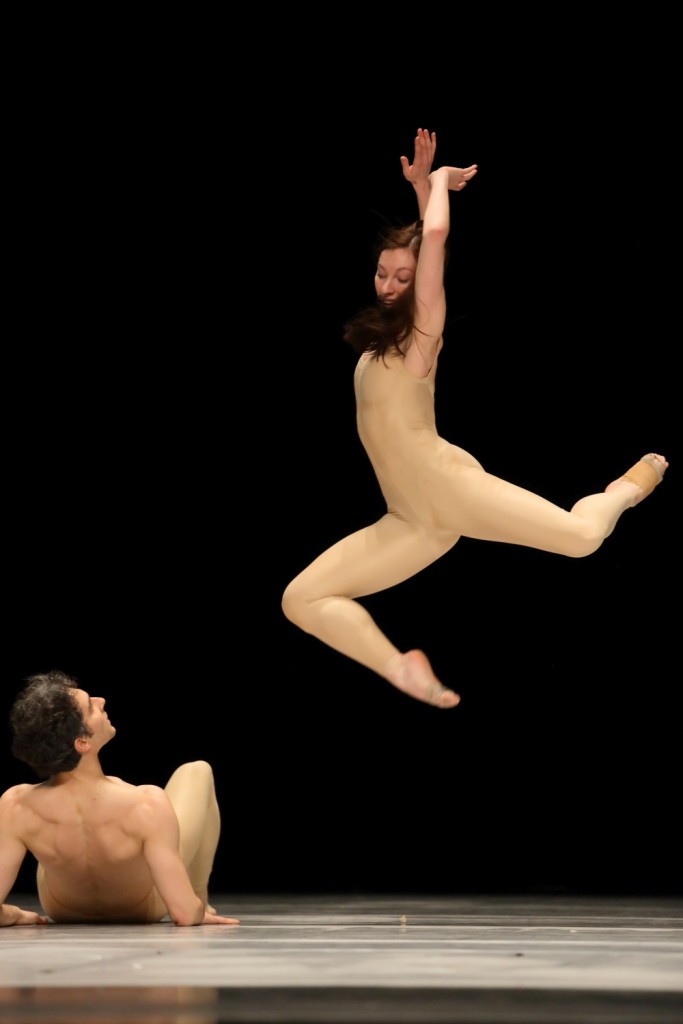 machinery. This time join-in activities were dropped. Instead the focus is entirely on the nearly one hour long choreography. Yet the work’s event-like character remains. Kylián mingles dance sequences with multiple videos and, above all, he strains for effect. When the auditorium slowly fills after the break, strobe lights cast dots of light that imitate flocks of birds whizzing past. Vertical blinds serve as backdrop, shimmering in silver and gray. Two dancers drag behind voluminous, so called “inflatable coats” by Yoshiki Hishinuma, a Japanese costume designer. These huge, objects are made of black nylon and filled with helium gas to make them float in the air. Two other dancers have geometrical objects fixed via straps to their upper bodies. These float like balloons above their heads reducing movement possibilities to a small range of careful steps. Two dresses are made of black film strips. They crackle with each of the dancers’ movements. Other dancers have miner’s lamps fastened around their heads. Sometimes, when videos are shown, a person walks up and down the dark stage with a torch. A few times a huge cloth covers the whole floor of the stage. When inflated from beneath, it undulates, looking like a water surface stirred up by heavy wind. Models of the theater in various sizes are part of the show and are a core element in the videos. At the end the models burst into flames, recalling the fires which damaged the National Theater in 1811 and destroyed it in 1823 and 1943.
machinery. This time join-in activities were dropped. Instead the focus is entirely on the nearly one hour long choreography. Yet the work’s event-like character remains. Kylián mingles dance sequences with multiple videos and, above all, he strains for effect. When the auditorium slowly fills after the break, strobe lights cast dots of light that imitate flocks of birds whizzing past. Vertical blinds serve as backdrop, shimmering in silver and gray. Two dancers drag behind voluminous, so called “inflatable coats” by Yoshiki Hishinuma, a Japanese costume designer. These huge, objects are made of black nylon and filled with helium gas to make them float in the air. Two other dancers have geometrical objects fixed via straps to their upper bodies. These float like balloons above their heads reducing movement possibilities to a small range of careful steps. Two dresses are made of black film strips. They crackle with each of the dancers’ movements. Other dancers have miner’s lamps fastened around their heads. Sometimes, when videos are shown, a person walks up and down the dark stage with a torch. A few times a huge cloth covers the whole floor of the stage. When inflated from beneath, it undulates, looking like a water surface stirred up by heavy wind. Models of the theater in various sizes are part of the show and are a core element in the videos. At the end the models burst into flames, recalling the fires which damaged the National Theater in 1811 and destroyed it in 1823 and 1943.
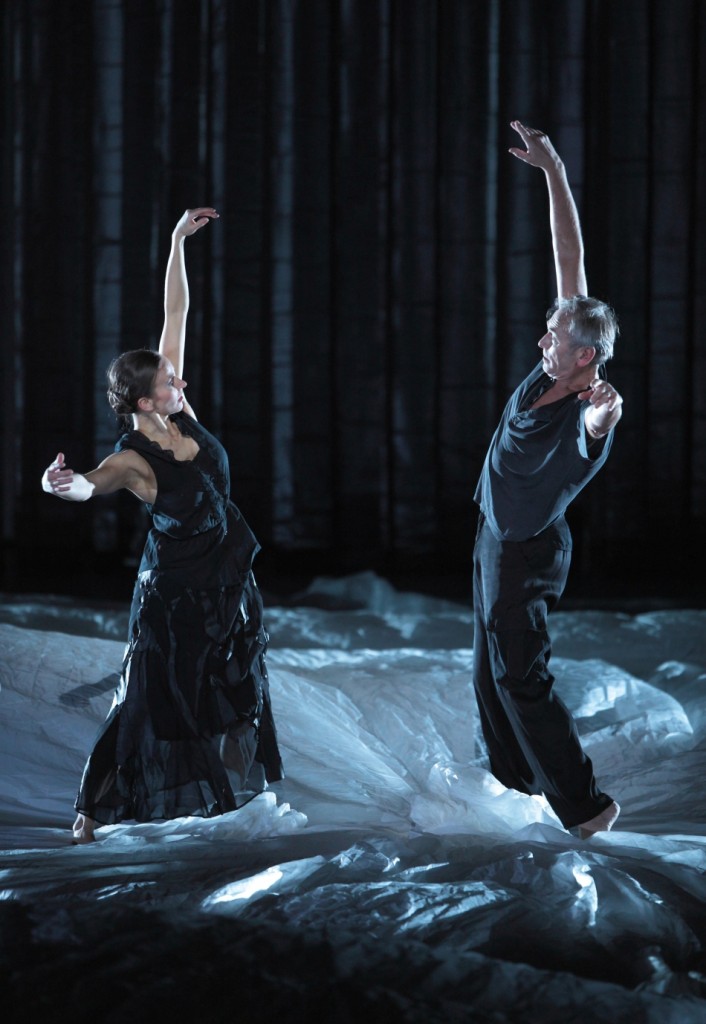 For the black and white videos, four in total, Kylián worked with the Dutch film maker Boris Paval Conen. Both had already collaborated on “Car-Men” in 2006. As in “Car-Men” Sabine Kupferberg, Kylián’s longtime private and professional partner, played the leading role. Roughly summarized, she faced growing old yet remembered being a nine-year-old girl. Richelle Plantinga plays the young girl. She finds a model of Munich’s National Theater at the beach, opens its roof and looks into it with amazement. It seems to be a magic box. Suddenly the theater grows to normal size but is located between the dunes instead of at the Max-Josephs-Platz in Munich’s city center! The remaining films show surrealistic, dream-like episodes in the theater. Kylián’s and Conen’s cameraman was Walther von der Ende who is highly gifted in capturing intriguing perspectives. For those familiar with “Car-Men” or the videos of “Birth-Day” (2001), however, nothing new was offered. Kylián repeats the same ideas with the same protagonist – Sabine Kupferberg – in the same style. What is worse, the four videos were partitioned into shorter clips, resulting in a succession of films which seemed never-ending. Finally after the third sequence the matter got tiresome.
For the black and white videos, four in total, Kylián worked with the Dutch film maker Boris Paval Conen. Both had already collaborated on “Car-Men” in 2006. As in “Car-Men” Sabine Kupferberg, Kylián’s longtime private and professional partner, played the leading role. Roughly summarized, she faced growing old yet remembered being a nine-year-old girl. Richelle Plantinga plays the young girl. She finds a model of Munich’s National Theater at the beach, opens its roof and looks into it with amazement. It seems to be a magic box. Suddenly the theater grows to normal size but is located between the dunes instead of at the Max-Josephs-Platz in Munich’s city center! The remaining films show surrealistic, dream-like episodes in the theater. Kylián’s and Conen’s cameraman was Walther von der Ende who is highly gifted in capturing intriguing perspectives. For those familiar with “Car-Men” or the videos of “Birth-Day” (2001), however, nothing new was offered. Kylián repeats the same ideas with the same protagonist – Sabine Kupferberg – in the same style. What is worse, the four videos were partitioned into shorter clips, resulting in a succession of films which seemed never-ending. Finally after the third sequence the matter got tiresome.
Caroline Geiger and Peter Jolesch depicting a couple advanced in years are the backbone of the choreography. Jolesch, a former dancer in the company, depicts an old, white-haired man with bushy eyebrows, clad in a casual, calf-length, dark coat. One could deem him a tramp. Geiger is also an ex-dancer. Kylián created an interesting pas de deux revolving around Jolesch’s coat and some acting parts. At he beginning, for example, Jolesch runs up and down the lowered orchestra pit trying to get up to Geiger who stands on stage in the spotlight. Apparently having superhuman powers Jolesch finally manages to press the whole stage down to his level and join Geiger. Later, after both had climbed out of the model of the 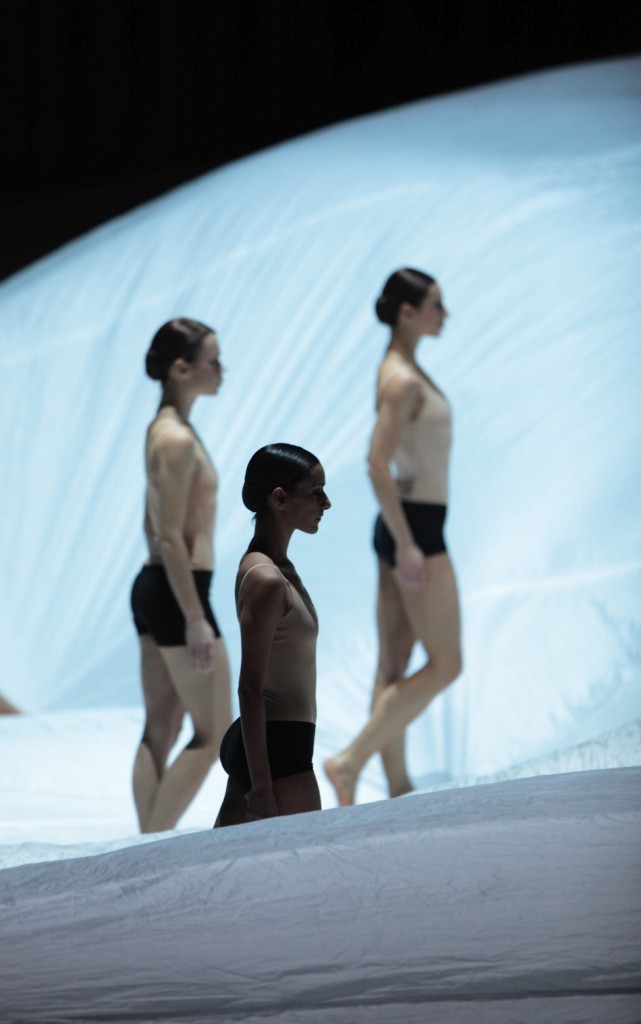 National Theater placed at the forestage, Geiger puts her hand on Jolesch’s crotch raising questions about how they had been spending their time in the model.
National Theater placed at the forestage, Geiger puts her hand on Jolesch’s crotch raising questions about how they had been spending their time in the model.
The dance sequences in between the films all look more or less the same except involving various numbers of dancers in different costumes. Usually they make a flapping sound when running on stage past the vertical blinds. Often they slid to a halt as if moving on icy ground but then fire off a combination of loose, flowing moves. The videos seem to be the more important elements while the dancing looks like a filler. Effects gloss over the flimsy choreography. Nevertheless the show could be entertaining, if its formula wasn’t so apparent.
Surprisingly Sophie Becker gives the impression of viewer’s being served a fluffy, entertaining show in her article about the music for “Zugvögel” printed in the program notes. Composer Dirk Haubrich assembled a score of electronic sounds. No objections to that, although the sounds sometimes lingered monotonously. Yet Becker mocks the way 19th century composers worked who, she imagines, sat in drafty garrets, and, taken by inspiration, wrote down their compositions in some kind of febrile delirium. But, she continues, knowing the compositional rules for new works the execution could safely be handed down to a computer these days. The instruments, that is the sounds, can simply be bought as downloadable files. In terms of “Zugvögel” ready-mades like Maurice Ravel’s “Bolero” were also included as were recordings of Kupferberg reciting the numbers of π and an altered version of the poem “I cannot grow” by W. H. Auden. Finally, to provide the music with a “human touch” instead of sounding clean and aseptic, mistakes were deliberately added. The procedure reminds me of eating fast food, the topping adding the special flavor, the whole at best boxed as a handy plastic take away. Goodbye inspiration. Goodbye creative genius. Let it be done by the computer.
| Links: | Bavarian State Ballet’s Homepage | |
| Photos: | (The photos show a partially different cast from an earlier performance.) | |
| “Artifact II” (William Forsythe) | ||
| 1. | Emma Barrowman, Javier Amo and ensemble, “Artifact II” by William Forsythe, Bavarian State Ballet, Munich 2015 | |
| 2. | Ensemble, “Artifact II” by William Forsythe, Bavarian State Ballet, Munich 2015 | |
| 3. | Lucia Lacarra and Tigran Mikayelyan, “Artifact II” by William Forsythe, Bavarian State Ballet, Munich 2015 | |
| “The Exiles” (José Limón) | ||
| 4. | Stephanie Hancox and Matej Urban, “The Exiles” by José Limón, Bavarian State Ballet, Munich 2015 | |
| 5. | Stephanie Hancox and Matej Urban, “The Exiles” by José Limón, Bavarian State Ballet, Munich 2015 | |
| 6. | Matej Urban and Stephanie Hancox, “The Exiles” by José Limón, Bavarian State Ballet, Munich 2015 | |
| “Zugvögel” (Jiří Kylián) | ||
| 7. | Caroline Geiger and Peter Jolesch, “Zugvögel” by Jiří Kylián, Bavarian State Ballet, Munich 2015 | |
| 8. | Ensemble, “Zugvögel” by Jiří Kylián, Bavarian State Ballet, Munich 2015 | |
| 9. | Ensemble, “Zugvögel” by Jiří Kylián, Bavarian State Ballet, Munich 2015 © DayKol 2015 | |
| all photos except no. 9 © Wilfried Hösl 2015 | ||
| Editing: | Laurence Smelser |
